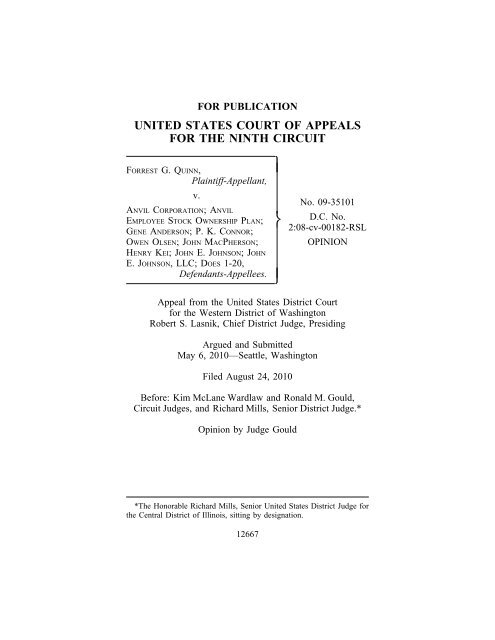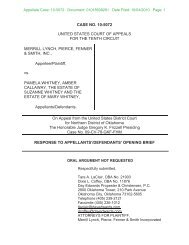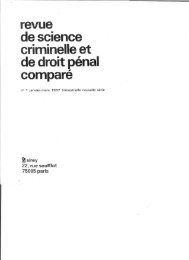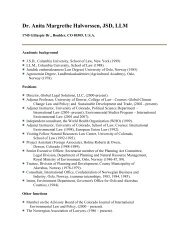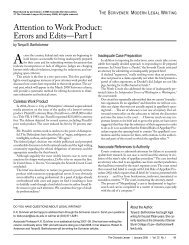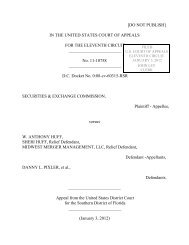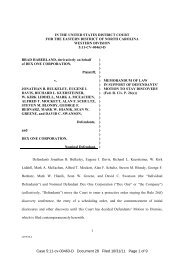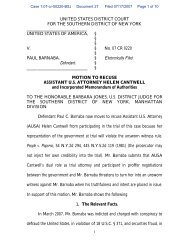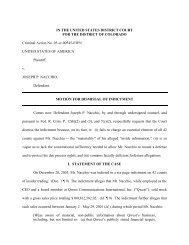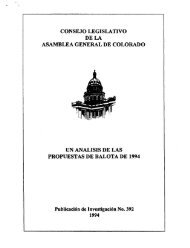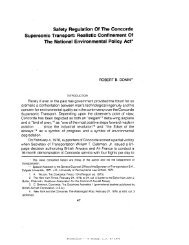Quinn v. Anvil Corp.
Quinn v. Anvil Corp.
Quinn v. Anvil Corp.
You also want an ePaper? Increase the reach of your titles
YUMPU automatically turns print PDFs into web optimized ePapers that Google loves.
FOR PUBLICATION<br />
UNITED STATES COURT OF APPEALS<br />
FOR THE NINTH CIRCUIT<br />
FORREST G. QUINN,<br />
Plaintiff-Appellant,<br />
v.<br />
ANVIL CORPORATION; ANVIL<br />
EMPLOYEE STOCK OWNERSHIP PLAN;<br />
GENE ANDERSON; P. K. CONNOR;<br />
OWEN OLSEN; JOHN MACPHERSON;<br />
⎫<br />
HENRY KEI; JOHN E. JOHNSON; JOHN<br />
E. JOHNSON, LLC; DOES 1-20,<br />
Defendants-Appellees.<br />
⎭<br />
No. 09-35101<br />
D.C. No.<br />
⎬ 2:08-cv-00182-RSL<br />
OPINION<br />
Appeal from the United States District Court<br />
for the Western District of Washington<br />
Robert S. Lasnik, Chief District Judge, Presiding<br />
Argued and Submitted<br />
May 6, 2010—Seattle, Washington<br />
Filed August 24, 2010<br />
Before: Kim McLane Wardlaw and Ronald M. Gould,<br />
Circuit Judges, and Richard Mills, Senior District Judge.*<br />
Opinion by Judge Gould<br />
*The Honorable Richard Mills, Senior United States District Judge for<br />
the Central District of Illinois, sitting by designation.<br />
12667
12670 QUINN v. ANVIL CORPORATION<br />
COUNSEL<br />
Mark Ferrario (argued), Tami D. Cowden, Greenberg Traurig,<br />
LLP, Las Vegas, Nevada, for the appellant.<br />
Scott A. Smith (argued), William P. Brewer, Riddell Williams<br />
P.S., Seattle, Washington, for the appellees.<br />
GOULD, Circuit Judge:<br />
OPINION<br />
Forrest <strong>Quinn</strong> appeals the district court’s judgment dismissing<br />
for lack of standing his diversity derivative action seeking<br />
damages from <strong>Anvil</strong> <strong>Corp</strong>oration (“<strong>Anvil</strong>”), its board of<br />
directors (the “Board”), and others for breach of fiduciary<br />
duty, breach of contract, and negligence. During the pendency<br />
of <strong>Quinn</strong>’s suit, <strong>Anvil</strong> proposed an amendment to its articles<br />
of incorporation (the “Amendment”), which, among other<br />
things, would effect a reverse stock split divesting <strong>Quinn</strong> of<br />
his fifty shares of <strong>Anvil</strong> stock. The district court denied<br />
<strong>Quinn</strong>’s motion preliminarily to enjoin the Amendment. After<br />
the Amendment passed, the court denied <strong>Quinn</strong>’s request for<br />
further discovery and dismissed <strong>Quinn</strong>’s derivative action<br />
because, lacking shares, <strong>Quinn</strong> lost standing to assert claims
QUINN v. ANVIL CORPORATION<br />
derivatively on behalf of the corporation under Federal Rule<br />
of Civil Procedure 23.1’s continuous ownership requirement.<br />
The district court denied <strong>Quinn</strong>’s motion for reconsideration<br />
of the dismissal. We have jurisdiction under 28 U.S.C.<br />
§ 1291, and we affirm.<br />
I<br />
12671<br />
<strong>Anvil</strong> is a privately held Washington company that provides<br />
engineering services to petroleum companies in the<br />
Northwest. <strong>Quinn</strong>’s uncle, Lorren Levorsen, founded <strong>Anvil</strong> in<br />
1971. <strong>Quinn</strong> was employed by <strong>Anvil</strong> in the late 1970s and<br />
early 1980s. In 1996, Levorsen established an Employee<br />
Stock Ownership Plan (“ESOP”) for <strong>Anvil</strong> employees. In<br />
1997, Levorsen gave his remaining <strong>Anvil</strong> stock to a family<br />
limited-liability company, with equal ownership interests<br />
divided among <strong>Quinn</strong>, Levorsen’s niece, and Levorsen’s two<br />
stepsons. Beginning in 2001, <strong>Quinn</strong> wrote letters to Levorsen<br />
and <strong>Anvil</strong>’s leadership urging the adoption of more aggressive<br />
strategies to increase the value of <strong>Anvil</strong>’s stock. <strong>Quinn</strong> also<br />
wrote <strong>Anvil</strong>’s executives to report asserted deficiencies that<br />
he perceived in the valuation of <strong>Anvil</strong>’s stock made in connection<br />
with the administration of the ESOP.<br />
Beginning in 2003, <strong>Quinn</strong> initiated a series of related lawsuits<br />
against <strong>Anvil</strong> and its leadership, alleging undervaluation<br />
of its stock. <strong>Quinn</strong>’s first lawsuit was dismissed on jurisdictional<br />
grounds shortly after being filed in 2003 in California.<br />
<strong>Quinn</strong>’s second lawsuit, brought in Washington state court in<br />
2004, was settled in 2007. In February 2008, <strong>Quinn</strong> filed this<br />
derivative shareholder suit in the United States District Court<br />
for the Western District of Washington. The only <strong>Anvil</strong> stock<br />
<strong>Quinn</strong> owned when he filed the suit was fifty shares given to<br />
him by his parents before the commencement of this suit.<br />
<strong>Quinn</strong> named as defendants <strong>Anvil</strong>, the ESOP, several thencurrent<br />
Board members, and others (“Defendants”). <strong>Quinn</strong><br />
alleged that appraisals used for ESOP valuation were flawed<br />
and resulted in undervaluation of <strong>Anvil</strong>’s stock. <strong>Quinn</strong> sought
12672 QUINN v. ANVIL CORPORATION<br />
damages for breach of fiduciary duty, breach of contract, and<br />
negligence.<br />
On July 14, 2008, while <strong>Quinn</strong>’s lawsuit was pending,<br />
<strong>Anvil</strong>’s Board unanimously adopted a resolution to amend<br />
<strong>Anvil</strong>’s articles of incorporation (the “Resolution”). The Resolution<br />
stated that the proposed Amendment would “restrict<br />
ownership of substantially all of the Company’s common<br />
stock to employees and the ESOP” and effect a reverse stock<br />
split whereby each sixty shares of Class A Common Stock<br />
would be automatically converted to one share of common<br />
stock. A shareholder with less than sixty shares would not be<br />
entitled to receive a fractional share, but would instead<br />
receive a cash payment in lieu thereof. Thus the Resolution<br />
would eliminate share ownership of those holding less than<br />
sixty shares. The Resolution set a shareholder vote on the<br />
Amendment for August 5, 2008.<br />
On or about July 15, 2008, <strong>Anvil</strong>’s Board distributed proxy<br />
materials to <strong>Anvil</strong>’s shareholders. The proxy materials said<br />
that the purpose of the Amendment was to facilitate employee<br />
ownership of <strong>Anvil</strong>, which <strong>Anvil</strong> considered to be an important<br />
part of its culture and also “important to its clients and<br />
suppliers.” The Amendment would achieve this goal by permitting<br />
<strong>Anvil</strong> to repurchase employees’ shares at the end of<br />
their employment and by conducting the reverse stock split.<br />
The proxy materials explained that, as a result of the reverse<br />
stock split, a shareholder with fewer than sixty shares would<br />
get cash but would “no longer be an <strong>Anvil</strong> shareholder.” One<br />
of the persons with fewer than sixty shares, the Board disclosed,<br />
was <strong>Quinn</strong>. Based on the Board’s determination that<br />
$120 exceeded the fair value of a share of Class A Common<br />
Stock, holders of fractional shares would receive a payment<br />
equivalent to the share fraction—the ratio of shares held<br />
divided by sixty shares—multiplied by $7,200. 1 The materials<br />
1 For example, a hypothetical shareholder owning 121 shares of Class A<br />
Common Stock would receive two new shares of common stock, and a<br />
cash payment of $120 for the 1/60 fractional share.
QUINN v. ANVIL CORPORATION<br />
12673<br />
also stated that a dissenting shareholder “with fewer than 60<br />
shares of Class A Common Stock” had appraisal rights to<br />
“obtain payment of the fair value of the shareholder’s shares.”<br />
On July 18, 2008, Defendants filed with the district court<br />
a “Notice of Action that May Leave Plaintiff with no <strong>Anvil</strong><br />
Shares.” The notice told <strong>Quinn</strong> and the court that an August<br />
5 shareholder meeting had been scheduled to vote on the<br />
Amendment, and that the Amendment, if approved, would,<br />
among other things, effect a reverse stock split leaving <strong>Quinn</strong><br />
with no shares and, consequently, no standing to pursue this<br />
case. <strong>Quinn</strong> moved for a temporary restraining order and for<br />
a preliminary injunction against the shareholder vote. On<br />
August 4, the district court denied the motion and, the next<br />
day, the shareholders approved the Amendment with near<br />
unanimity. <strong>Quinn</strong> notified <strong>Anvil</strong> that he would exercise his<br />
appraisal rights.<br />
Thereafter, Defendants filed a supplemental motion to dismiss<br />
the action for lack of standing. The district court stayed<br />
further discovery pending resolution of the motion. <strong>Quinn</strong><br />
opposed the motion with declarations and exhibits, and simultaneously<br />
moved for leave to conduct discovery, arguing that<br />
further discovery was necessary to oppose Defendants’<br />
motion. The court granted the supplemental motion to dismiss,<br />
reasoning that because <strong>Quinn</strong> no longer held any shares<br />
of <strong>Anvil</strong> stock, he did not meet Federal Rule of Civil Procedure<br />
23.1’s requirement that a plaintiff in a derivative shareholder<br />
suit hold shares throughout the litigation. The district<br />
court rejected <strong>Quinn</strong>’s argument that the reverse stock split<br />
should be unwound due to fraud or procedural irregularity,<br />
reasoning that <strong>Quinn</strong> had no evidence of fraud and that the<br />
procedural irregularities asserted by <strong>Quinn</strong> were unsupported<br />
or immaterial. The district court also rejected as without foundation<br />
in Ninth Circuit caselaw <strong>Quinn</strong>’s argument that he<br />
should be able to maintain his derivative suit based on equitable<br />
considerations because, as <strong>Quinn</strong> contended, <strong>Anvil</strong>’s<br />
reverse stock split had no purpose other than to end his law-
12674 QUINN v. ANVIL CORPORATION<br />
suit. The district court was not persuaded that <strong>Quinn</strong> was entitled<br />
to further discovery.<br />
<strong>Quinn</strong> moved for reconsideration of the dismissal and<br />
argued, based on financial information he received from<br />
<strong>Anvil</strong> after electing appraisal, that <strong>Anvil</strong> had undervalued its<br />
shares in setting the compensation for fractional shares in the<br />
reverse stock split. The district court denied <strong>Quinn</strong>’s motion,<br />
concluding that even if it considered this new evidence, it<br />
would not unwind the reverse stock split because the new evidence<br />
did not suggest fraud. <strong>Quinn</strong>’s timely appeal followed.<br />
II<br />
The first issue raised by <strong>Quinn</strong>’s appeal is whether we<br />
should reverse the district court’s decisions not to enjoin or<br />
unwind the reverse stock split and restore <strong>Quinn</strong>’s shares.<br />
<strong>Quinn</strong>’s request that the district court unwind the reverse<br />
stock split is properly understood as a request for preliminary<br />
equitable relief. See Yamamoto v. Omiya, 564 F.2d 1319,<br />
1323-24 (9th Cir. 1977) (shareholder’s suit seeking to void a<br />
sale consummated through allegedly misleading and deceptive<br />
proxy solicitations characterized as a request for “equitable<br />
relief”). 2 We review the district court’s decisions denying<br />
the preliminary injunction against the reverse stock split for<br />
abuse of discretion. See Nader v. Brewer, 386 F.3d 1168,<br />
1169 (9th Cir. 2004) (per curiam) (denial of preliminary<br />
injunction reviewed for abuse of discretion); see also Mac-<br />
Donald v. Grace Church Seattle, 457 F.3d 1079, 1081 (9th<br />
Cir. 2006) (denial of motion for reconsideration reviewed for<br />
abuse of discretion). A district court abuses its discretion in<br />
denying a preliminary injunction if it bases its decision on “an<br />
erroneous legal standard or clearly erroneous findings of<br />
2 To the extent that <strong>Quinn</strong> argues that the reverse stock split was inoperative<br />
to deprive him of standing even though he now has no shares, his<br />
argument is that he has equitable standing, which we address below in Part<br />
III.
QUINN v. ANVIL CORPORATION<br />
12675<br />
fact.” Cal. Pharmacists Ass’n v. Maxwell-Jolly, 596 F.3d<br />
1098, 1104 (9th Cir. 2010); see also United States v. Hinkson,<br />
585 F.3d 1247, 1262 (9th Cir. 2009) (en banc).<br />
[1] <strong>Quinn</strong> attacks the reverse stock split on two state-law<br />
grounds: first, that it was fraudulent, and second, that the<br />
Amendment was procedurally flawed. Entitlement to a preliminary<br />
injunction requires showing, among other things,<br />
likely success on the merits. Cal. Pharmacists, 596 F.3d at<br />
1104. Because <strong>Quinn</strong> sought the appraisal remedy, Washington<br />
law precludes him from attacking the Amendment unless<br />
he shows that it was fraudulent or procedurally flawed. See<br />
Wash. Rev. Code § 23B.13.020(2); Sound Infiniti, Inc. v. Snyder,<br />
186 P.3d 1107, 1112 (Wash. Ct. App. 2008), review<br />
granted 203 P.3d 379. <strong>Quinn</strong>, however, has not demonstrated<br />
likelihood of success on the merits of his state-law claims that<br />
the Amendment involved fraud or procedural irregularity. We<br />
hold that the district court was within its discretion in not<br />
enjoining or unwinding the reverse stock split. 3<br />
See Cal.<br />
Pharmacists, 596 F.3d at 1104; Hinkson, 585 F.3d at 1262.<br />
[2] Arguing that the Amendment was fraudulent, <strong>Quinn</strong><br />
takes issue with the Board’s statements in the proxy materials<br />
that $120 was “not less than the current fair value” of a share<br />
of Class A Common Stock and was “higher than its current<br />
value.” Under Washington law, a representation is only fraudulent<br />
if it is both material and false. See Baertschi v. Jordan,<br />
413 P.2d 657, 660 (Wash. 1966). The district court did not<br />
find the representations concerning the share value fraudulent,<br />
stating, “Plaintiff seeks to draw a one-to-one correlation<br />
between net income and stock price, a valuation process that<br />
3 The district court articulated the preliminary injunction standard in<br />
denying <strong>Quinn</strong>’s motion for preliminary relief. Although the district court,<br />
in its orders granting Defendants’ supplemental motion to dismiss and<br />
denying <strong>Quinn</strong>’s motion for reconsideration, did not again recite this standard<br />
in declining to unwind the reverse stock split, we may affirm the dismissal<br />
on any ground supported by the record. See United States v.<br />
Washington, 573 F.3d 701, 706 (9th Cir. 2009).
12676 QUINN v. ANVIL CORPORATION<br />
ignores all other facts that affect the value of a company’s<br />
stock (such as one-time asset sales, planned expenditures, and<br />
prospects for new business).” This finding was not clearly<br />
erroneous. The $120 figure exceeded the most recent<br />
independent-appraisal price of $93.97 and was also higher<br />
than prior independent appraisals. Nor was the share price<br />
material to the Amendment because <strong>Anvil</strong>’s shareholders,<br />
other than those few with less than sixty shares, retained their<br />
equity in <strong>Anvil</strong> with only fractional shares cashed out. See<br />
Martin v. Miller, 600 P.2d 698, 699-700 (Wash. Ct. App.<br />
1979) (stating that a fact is material if a reasonable person<br />
would attach importance to its existence in determining his or<br />
her action).<br />
[3] <strong>Quinn</strong> next contends that the proxy materials were<br />
fraudulent because they omitted material facts. <strong>Quinn</strong> argues<br />
that it was fraud for <strong>Anvil</strong> not to disclose <strong>Quinn</strong>’s allegations,<br />
that the Amendment would end <strong>Quinn</strong>’s lawsuit, that <strong>Anvil</strong><br />
employees who brought future derivative suits would risk termination,<br />
and that certain <strong>Anvil</strong> Board members had conflicts<br />
of interest because they either had a financial interest in the<br />
Amendment due to their acquisition of undervalued option<br />
stock or are defendants (or related to a defendant) in this suit.<br />
But these omissions were not fraudulent because <strong>Quinn</strong> has<br />
not established that there is a substantial likelihood that this<br />
information would have been important to shareholders in<br />
deciding how to vote on the Amendment. See Guarino v.<br />
Interactive Objects, Inc., 86 P.3d 1175, 1185 (Wash. Ct. App.<br />
2004). The proxy materials disclosed that the Amendment<br />
would divest <strong>Quinn</strong> of his shares, severing <strong>Anvil</strong>’s relationship<br />
with <strong>Quinn</strong>. The Amendment was neither a referendum<br />
on the directors nor the independent appraisal process, so the<br />
greater specificity concerning <strong>Quinn</strong>’s allegations and the<br />
nature of his lawsuit that <strong>Quinn</strong> suggests was required was not<br />
necessary. There was no need for <strong>Anvil</strong> to disclose that<br />
employees would bring future suits at risk of termination<br />
because <strong>Quinn</strong>’s contention of potential retaliation is unsupported.
QUINN v. ANVIL CORPORATION<br />
Concerning the alleged Board-member conflicts, we reject<br />
<strong>Quinn</strong>’s conclusory assertion that certain Board members<br />
were conflicted because they “owned shares based on <strong>Anvil</strong>’s<br />
faulty appraisals.” And even assuming, as <strong>Quinn</strong> argues, that<br />
three of the seven Board members—P.K. Connor, John Mac-<br />
Pherson, and Scott Anderson—were conflicted because of<br />
their ties to this suit, the remaining four directors unanimously<br />
voted to adopt the Amendment. This was sufficient to establish<br />
a quorum, see Wash. Rev. Code § 23B.08.720(3), and to<br />
validly ratify the Amendment, see id. §§ 23B.08.710,<br />
23B.08.720(1). <strong>Anvil</strong>’s treatment of these alleged conflicts, if<br />
they were conflicts at all, was procedurally proper and not<br />
fraudulent.<br />
[4] <strong>Quinn</strong> also did not show that the Amendment was otherwise<br />
procedurally flawed. <strong>Quinn</strong> argues that shareholders<br />
had to approve the Amendment through separate group voting.<br />
See Wash. Rev. Code § 23B.10.040(1). <strong>Quinn</strong> is mistaken.<br />
The Redemption Agreement between Levorsen and<br />
<strong>Anvil</strong> did not create a separate series or class of stock entitled<br />
to a separate vote. 4<br />
Separate group voting was unnecessary.<br />
Because <strong>Quinn</strong> cannot show likelihood of success on his<br />
state-law claims of fraud and procedural infirmity in the<br />
Amendment, we conclude that the district court did not abuse<br />
its discretion in declining preliminarily to enjoin or unwind<br />
the reverse stock split.<br />
III<br />
12677<br />
The second issue raised by <strong>Quinn</strong>’s appeal is whether,<br />
despite not holding shares after the Resolution was implemented,<br />
<strong>Quinn</strong> meets Federal Rule of Civil Procedure 23.1’s<br />
standing requirements for a shareholder derivative action. We<br />
review de novo whether <strong>Quinn</strong> has derivative standing to<br />
4 Because we earlier concluded that <strong>Quinn</strong> has not shown that the<br />
Amendment was fraudulent, we likewise reject his contention that fraud<br />
rendered the Amendment procedurally infirm.
12678 QUINN v. ANVIL CORPORATION<br />
assert claims on behalf of <strong>Anvil</strong>. Kona Enters., Inc. v. Estate<br />
of Bishop, 179 F.3d 767, 769 (9th Cir. 1999).<br />
[5] The normal rule is that a corporation is run by its management,<br />
and the corporation itself has the right to make<br />
claims. See Potter v. Hughes, 546 F.3d 1051, 1058 (9th Cir.<br />
2008) (“[T]he general rule of American law is that the board<br />
of directors controls a corporation.”). A derivative action is an<br />
extraordinary process where courts permit “a shareholder to<br />
step into the corporation’s shoes and to seek in its right the<br />
restitution he could not demand in his own.” Lewis v. Chiles,<br />
719 F.2d 1044, 1047 (9th Cir. 1983) (quotation marks omitted);<br />
see Kayes v. Pac. Lumber Co., 51 F.3d 1449, 1463 (9th<br />
Cir. 1995) (“Because of the fear that shareholder derivative<br />
suits could subvert the basic principle of management control<br />
over corporate operations, courts have generally characterized<br />
shareholder derivative suits as a remedy of last resort.” (quotation<br />
marks omitted)).<br />
[6] Because of the extraordinary nature of a shareholder<br />
derivative suit, Rule 23.1 establishes stringent conditions for<br />
bringing such a suit. Potter, 546 at 1058 (“[S]trict compliance<br />
with Rule 23.1 and the applicable substantive law is necessary<br />
before a derivative suit can wrest control of an issue from the<br />
board of directors.”). First, plaintiffs must comply with Rule<br />
23.1’s pleading requirements, including that the plaintiff “allege<br />
with particularity the efforts, if any, made by the plaintiff<br />
to obtain the action the plaintiff desires from the directors.”<br />
Id. at 1056 (quotation marks omitted); see Fed. R. Civ. P.<br />
23.1(b). Second, Rule 23.1 states that a derivative action<br />
brought by “one or more shareholders . . . to enforce a right”<br />
of a corporation “may not be maintained if it appears that the<br />
plaintiff does not fairly and adequately represent the interests<br />
of shareholders or members who are similarly situated in<br />
enforcing the right of the corporation or association.” Fed. R.<br />
Civ. P. 23.1(a). We have inferred from this language not only<br />
“that a derivative plaintiff be a shareholder at the time of the<br />
alleged wrongful acts” but also “that the plaintiff retain own-
QUINN v. ANVIL CORPORATION<br />
12679<br />
ership of the stock for the duration of the lawsuit”—the socalled<br />
“continuous ownership requirement.” Lewis, 719 F.2d<br />
at 1047. If a shareholder is divested of his or her shares during<br />
the pendency of litigation, that shareholder loses standing. See<br />
id.<br />
[7] This second requirement, the continuous ownership<br />
requirement, as the district court properly recognized, forecloses<br />
<strong>Quinn</strong>’s derivative action. By operation of the reverse<br />
stock split, <strong>Quinn</strong>’s fifty shares were cancelled and <strong>Quinn</strong><br />
thereafter held no <strong>Anvil</strong> stock. <strong>Quinn</strong>’s derivative claims are<br />
an “intangible asset” belonging to <strong>Anvil</strong>, not to <strong>Quinn</strong>. See id.<br />
<strong>Quinn</strong>, a nonshareholder, cannot benefit from any recovery<br />
the company obtains from Defendants in a derivative suit and<br />
therefore, unlike <strong>Anvil</strong>’s continuing shareholders, <strong>Quinn</strong> does<br />
not have “an interest in pursuing the claims.” See id. We<br />
therefore hold that, after the reverse stock split, <strong>Quinn</strong> did not<br />
meet Rule 23.1’s continuous ownership requirement.<br />
<strong>Quinn</strong> nevertheless urges us to recognize an exception to<br />
Rule 23.1’s continuous ownership requirement because, as he<br />
describes it, <strong>Anvil</strong> conducted the reverse stock split only to<br />
terminate his pending lawsuit, and the Amendment was permeated<br />
by fraud and procedural flaws. 5<br />
We have rejected<br />
applying an equitable exception to the continuous ownership<br />
requirement, and <strong>Quinn</strong> provides no compelling reason why<br />
we should apply one now. See id. at 1046-48 (rejecting argument<br />
of former shareholder that we should recognize equitable<br />
standing where the company’s leadership conducted an<br />
asset sale during the pendency of the litigation to allegedly<br />
“insulat[e] themselves from liability”); 6 Kona, 179 F.3d at 770<br />
5 Although <strong>Quinn</strong> and <strong>Anvil</strong> present arguments about whether <strong>Quinn</strong><br />
would have standing under Washington law, we need not decide this issue.<br />
The continuous ownership requirement imposed by Rule 23.1 of the Federal<br />
Rules of Civil Procedure is procedural and therefore applies in diversity<br />
actions such as this one. Kona, 179 F.3d at 769.<br />
6 <strong>Quinn</strong> attempts to distinguish Lewis, arguing that, unlike in Lewis, 719<br />
F.2d at 1048, here there was inadequate disclosure concerning the Board
12680 QUINN v. ANVIL CORPORATION<br />
(rejecting equitable standing where former shareholder did<br />
not challenge the stock foreclosure that divested shareholder<br />
of shares and company was still in existence).<br />
[8] To the extent that other courts have recognized exceptions<br />
to the continuous ownership requirement, these exceptions<br />
are inapplicable here. First, some courts have recognized<br />
equitable standing where a shareholder challenges a corporate<br />
transaction that resulted in no continuing shareholders that<br />
could bring derivative claims. In Lewis, for example, we cited<br />
state court decisions recognizing equitable standing “when<br />
officers or directors breached their fiduciary duty in connection<br />
with” a corporate merger that resulted in “dissolution of<br />
a corporation.” 719 F.2d at 1048 (emphasis added). Similarly,<br />
the cases we cited in Kona (and relied upon by <strong>Quinn</strong>)<br />
involved challenges to stock foreclosures or mergers where,<br />
absent equitable standing, none of the original shareholders<br />
could bring a claim on behalf of the company. 179 F.3d at 770. 7<br />
Although <strong>Quinn</strong> challenges the divesting transaction as fraudulent<br />
or procedurally flawed, his state-law claims are inadequate<br />
to support preliminary relief, and his challenge does not<br />
fit within this exception because he challenges only a reverse<br />
stock split. After the reverse stock split, in contrast to a stock<br />
sale (or foreclosure) depriving all original shareholders of<br />
stock or a merger involving a disappearing company, <strong>Anvil</strong>’s<br />
corporate personhood persists with its original shareholders<br />
continuing to hold stock in <strong>Anvil</strong> (unless they held fewer than<br />
sixty shares). The interest that motivated the recognition of<br />
equitable standing in the cases above—ensuring that a meanmembers’<br />
purported conflicts and <strong>Quinn</strong>’s allegations. Even assuming that<br />
<strong>Anvil</strong>’s disclosure to shareholders was less extensive than that in Lewis,<br />
that alone is not enough for us to conclude that equity warrants a different<br />
result here.<br />
7 The state cases cited by <strong>Quinn</strong> likewise involved challenges to mergers.<br />
See Lewis v. Anderson, 477 A.2d 1040, 1046 n.10 (Del. 1984) (recognizing<br />
exceptions to the continuous ownership requirement in certain<br />
merger cases); Platt <strong>Corp</strong>. v. Platt, 21 A.D.2d 116, 124 (N.Y. App. Div.<br />
1964) (company ceased to exist after merger).
QUINN v. ANVIL CORPORATION<br />
12681<br />
ingful mechanism exists to review the lawfulness of a transaction<br />
that divests all former shareholders of shares—is not<br />
implicated here.<br />
[9] Second, courts have suggested that equitable standing<br />
may be appropriate where there is no business justification for<br />
a transaction other than to terminate a lawsuit. See Zauber v.<br />
Murray Sav. Ass’n., 591 S.W.2d 932, 938 (Tex. Civ. App.<br />
1979) (“If no valid business purpose exists, a court of equity<br />
will consider the destruction of a stockholder’s status a nullity<br />
and allow him to proceed with the suit in the name of the corporation.”);<br />
Teschner v. Chicago Title & Trust Co., 322<br />
N.E.2d 54, 57-58 (Ill. 1974) (upholding a reverse stock split<br />
where the defendant corporation represented that the purpose<br />
of the reverse stock split was “to reduce corporate expenses<br />
and simplify and facilitate procedures”). <strong>Anvil</strong>’s Resolution<br />
and proxy materials explicitly related the Amendment’s legitimate<br />
business purpose of consolidating ownership of <strong>Anvil</strong><br />
within its employees for the benefit of <strong>Anvil</strong>’s employees, its<br />
culture, and its relationship with clients and suppliers. 8 <strong>Quinn</strong>,<br />
however, has not offered credible evidence, but rather only<br />
his self-serving assertions that the purpose of <strong>Anvil</strong>’s Amendment<br />
was to terminate his lawsuit. Because evidence showed<br />
a legitimate reason for the transaction, this exception is therefore<br />
likewise inapplicable.<br />
[10] Nor does our decision leave <strong>Quinn</strong> without potential<br />
recourse for his grievances. A shareholder derivative suit is “a<br />
remedy of last resort,” Kayes, 51 F.3d at 1463, and <strong>Quinn</strong> had<br />
available to him in his appraisal rights a remedy of first resort.<br />
Moreover, to the extent that <strong>Quinn</strong> is personally aggrieved,<br />
8 Although <strong>Anvil</strong> acknowledged that one of the consequences of the<br />
Amendment was that <strong>Quinn</strong> lost standing to pursue his lawsuit and that the<br />
shareholders were motivated in part to pass the Amendment in the hopes<br />
that it would end the litigation, <strong>Anvil</strong> has consistently maintained that the<br />
Amendment was motivated with the legitimate business purpose of<br />
employee ownership in mind.
12682 QUINN v. ANVIL CORPORATION<br />
his recourse would be to bring a direct action against <strong>Anvil</strong>.<br />
Equity does not favor permitting <strong>Quinn</strong> standing to pursue<br />
derivative claims on behalf of <strong>Anvil</strong>, contrary to the requirements<br />
of Federal Rule of Civil Procedure 23.1 as consistently<br />
interpreted by us to require continuous ownership.<br />
<strong>Quinn</strong> next protests that the district court, in deciding that<br />
he did not meet Rule 23.1’s standing requirements, erred by<br />
not taking as true his allegations that the Amendment was<br />
fraudulent, procedurally infirm, and without legitimate business<br />
purpose, instead holding him to a level of proof required<br />
at trial. But <strong>Quinn</strong> advanced no argument to the district court,<br />
either in opposing dismissal or on reconsideration, that he was<br />
entitled to rest on these allegations, without commensurate<br />
proof, to establish standing. To the contrary, <strong>Quinn</strong> addressed<br />
Defendants’ evidence head on and submitted declarations and<br />
many exhibits. We will not entertain <strong>Quinn</strong>’s attack on the<br />
procedure used by the district court in deciding <strong>Quinn</strong>’s suitability<br />
as a plaintiff under Rule 23.1. See Hornreich v. Plant<br />
Indus., Inc., 535 F.2d 550, 552 (9th Cir. 1976) (“In determining<br />
the adequacy of appellant as a representative of other<br />
shareholders [under Rule 23.1], the court was entitled to rely<br />
not only upon the pleadings, but also the affidavits submitted<br />
by the parties relating information of direct consequence to<br />
the issue before the court. The appellant having made no<br />
objection to the procedure followed in the district court . . .<br />
is in no position to complain.” (citations omitted)); United<br />
States v. Flores-Payon, 942 F.2d 556, 558 (9th Cir. 1991)<br />
(“Issues not presented to the trial court cannot generally be<br />
raised for the first time on appeal.”).<br />
[11] But our decision would be the same even if we gave<br />
full force to <strong>Quinn</strong>’s position. <strong>Quinn</strong> quotes Lujan v. Defenders<br />
of Wildlife, 504 U.S. 555 (1992), for the proposition that<br />
he need only establish standing “with the manner and degree<br />
of evidence required at the successive stages of the litigation,”<br />
id. at 561. <strong>Quinn</strong> conceded in his opening brief that Defendants’<br />
supplemental motion to dismiss “addressed matters that
QUINN v. ANVIL CORPORATION<br />
occurred subsequent to the filing of the Complaint, and<br />
included matters extraneous to the pleadings,” and the district<br />
court “could have considered the motion under the standards<br />
of [Federal Rule of Civil Procedure] 56.” If, as <strong>Quinn</strong> argues,<br />
Lujan’s standard applies, it directs that <strong>Quinn</strong> could “no longer<br />
rest on . . . mere allegations,” and at bare minimum had<br />
to “set forth by affidavit or other evidence specific facts”<br />
demonstrating that he met the requirements for derivative<br />
standing. Id. (quotation marks omitted). He failed adequately<br />
to do this. Although <strong>Quinn</strong> opposed with declarations and<br />
exhibits the supplemental motion to dismiss, <strong>Quinn</strong> did not<br />
show that he met the continuous ownership requirement of<br />
Rule 23.1. We hold that the district court properly dismissed<br />
<strong>Quinn</strong>’s action and was within its discretion in denying reconsideration<br />
of the dismissal.<br />
IV<br />
12683<br />
<strong>Quinn</strong> also challenges the district court’s denial of his<br />
motion for leave to conduct discovery. We review district<br />
court rulings on discovery matters for abuse of discretion.<br />
Childress v. Darby Lumber, Inc., 357 F.3d 1000, 1009 (9th<br />
Cir. 2004).<br />
[12] <strong>Quinn</strong> contends that additional discovery was necessary<br />
to oppose Defendants’ supplementary motion to dismiss.<br />
It is not settled how much, if any, discovery a derivative<br />
plaintiff is entitled to receive before opposing a motion to dismiss<br />
for noncompliance with Rule 23.1’s continuous ownership<br />
requirement. Cf. In re Merck & Co., Inc. Secs.,<br />
Derivative & ERISA Litig., 493 F.3d 393, 400 (3d Cir. 2007)<br />
(“[D]erivative plaintiffs are not entitled to discovery to assist<br />
their compliance with Rule 23.1” (internal quotation marks<br />
omitted)); but cf. Fagin v. Gilmartin, 432 F.3d 276, 285 & n.2<br />
(3d Cir. 2005) (stating that although “Rule 23.1 does not<br />
address discovery, neither allowing nor prohibiting it,” where<br />
material outside the pleadings must be assessed in deciding<br />
demand futility, “limited discovery seems in order”). Assum-
12684 QUINN v. ANVIL CORPORATION<br />
ing without deciding that some discovery is warranted in<br />
opposing a motion to dismiss predicated on Rule 23.1’s continuous<br />
ownership requirement where facts outside the pleadings<br />
must be considered, <strong>Quinn</strong> had an opportunity to conduct<br />
discovery in advance of the shareholder vote. <strong>Quinn</strong> did not<br />
demonstrate that further opportunity for discovery was justified<br />
or warranted. Contrary to <strong>Quinn</strong>’s contentions, he was<br />
not entitled to further discovery or a hearing concerning the<br />
valuation issues that underlie his derivative claims. As the district<br />
court noted, the valuation issue “ha[d] been beaten to<br />
death, it seems, over the years of litigation.”<br />
[13] Although <strong>Quinn</strong> claimed that protective orders prevented<br />
him from using material obtained through prior litigation,<br />
<strong>Quinn</strong> never filed a motion seeking relief from any<br />
protective orders. <strong>Quinn</strong>’s one-sentence request to use confidential<br />
documents obtained in other litigation without filing<br />
them under seal contained at the end of his “Statement<br />
Regarding Filing Documents Under Seal” was not a formal<br />
motion for relief from the protective order, and the district<br />
court was within its discretion in not granting a request so tendered.<br />
We hold that the district court did not abuse its discretion<br />
in denying <strong>Quinn</strong> further discovery. See Hinkson, 585<br />
F.3d at 1262.<br />
AFFIRMED.


